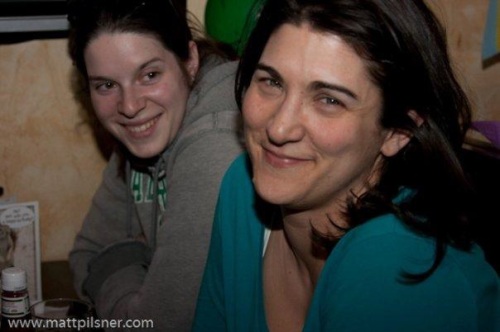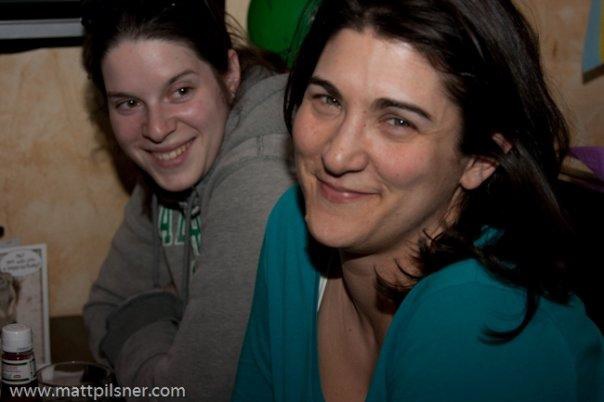The following is one of several interviews conducted by students of Ron DeMarco’s properties class at Emerson College.
It’s Not All Crafts and Games Here: Prop Master Michele Sammarco
By Alta Lewis Millard

In the city of Princeton New Jersey, most would expect to find many-a bright young college student from the esteemed Ivy League school, and they probably would. However, this historic town is also the home of the Tony Award-winning theatre company, the McCarter Theatre Center. Michele Sammarco, the props master at the McCarter, has been there for almost seventeen seasons.
Michele took the time out of her very busy schedule to exchange a few e-mails with me. Now it’s normal for those in the field of props to be busy, but I learnt after our exchange just how busy she had been. During our correspondence, Michele had been displaced from her apartment because the building had caught fire. Luckily she was all right and, aided by family, friends, and co-workers, she was able to retrieve most of the belongings that were not burned in the fire before the building was torn down. In an email correspondence shared with my class, Michele thanked those who helped, especially those who she works with. She said, “I’m grateful for them every day,” and credited their support to why she is “still in this crazy business.”
Michele became interested in theatre in high school, where she took on the roles of tech crew and assistant director. These experiences sparked her interest and she went on to study theatre at Northwestern University. “I graduated with a BS in Speech Sciences, which is their degree for theatre,” she said. During her time at Northwestern, she didn’t really study props, but after she graduated she took the first job that she could. “A new, small theatre was looking for someone to be the prop master for their show, and honestly, I think they were desperate. I approached the job in a more organizational manner since I wasn’t an artisan who was going to build things. Organization is really my strong suit,” she said. From that, she got a summer job working as a prop master and was hooked.
When I asked her how she had come to work at the McCarter Michele said, “I did a year or two as an assistant production manager at that same first theatre before the prop master at McCarter called me. She was looking for an assistant and heard from someone I worked with at the summer gig that I was good. McCarter’s prop master was a real artisan, and wanted someone to take over a lot of the organizational aspects and the shopping. We sort of made the perfect pair.” I also was interested in whether she had done any work outside of the theatre world and she responded, “I used to do some temp work in medical records for money, but I no longer have a desperate need or the tolerance for that stuff anymore.”
Michele said, “I think there is very little routine in theatre,” when I asked her what her daily routine looked like. She described her days at work as, “making sure everyone has everything they need to do their job. That might be materials, time, money, help, space, consultation, and most especially information. That might require e-mails, phone calls, carrying and toting, errands, whatever. The closest thing we have to a routine is when rehearsals are going on. I go over the stage manager’s rehearsal notes from the day before. I make sure we gather whatever they have added and get it over there; I answer questions they have and respond to all requests that require it.”
I was a bit confused on what the difference was between a props artisan and a manager was, so I asked her which skills were important for both titles. She explained that a props master “must be organized, have good communication skills, be willing to listen and be vocal enough to speak up for your staff and your work. You have to have a good eye for design and a broad knowledge of styles, but you do not have to be a designer. You have to be willing to learn constantly, as there is always something new in your path. You have to be good at problem solving work well with a team. You have to lead, but not micro-manage. Some prop masters are artisans, but I am not. I’m a manager, but I’ve done props solo and I know what my staff needs to get things done.”
On the other hand, a prop artisan is a bit more of an open description. Michele explained, “Artisan skills vary greatly. Everyone has his or her strengths and no one, really, excels at everything. There is sculpting, painting, woodworking, crafting, mechanics, upholstery/soft goods, and metalworking. When hiring an artisan, you have to find someone who has the strongest skills in the things you do most. Or, you may be lucky enough to have multiple artisans who have varying skills.”
I noticed that there were four other people who also worked in the props department at the McCarter. I asked Michele about how this set up worked in terms of keeping the vision of the show and divvying up the duties. She went on to describe her co-worker’s jobs. “I have a shopper, Meghan, who has to understand not just what the exact thing is she is looking for, but the intent of that thing so that she can provide alternatives. I weed out the alternatives before they are presented to the designer. She also does the computer graphics for the paper props. My artisan, Laura, does upholstery/soft goods, painting, and general crafts. Hers is probably the job with the most input besides me. She does so many different things that can be accomplished in so many ways, and she really has to communicate what she can actually accomplish and what she thinks just won’t work. My carpenter, Grant, does woodworking, metalworking, and electronics/mechanics. He is basically his own technical director. If we’re building a piece of furniture, we don’t get drawings you can actually build from. He has to interpret them and turn them into something he can actually build. I help him understand the intent of the design and make choices that are within that. My runner, Kristina, has to be the most pleasant, as she deals directly with the actors. She doesn’t get to affect the outcome of the props, but she has to make sure they maintain their look and integrity.” She then talked about her job in relation to the jobs she manages. “The vision is my biggest responsibility. I have to make sure everyone is executing the design as closely as possible. I collaborate directly with each person, and they collaborate alternately with each other. The shopper makes sure what she’s buying is something we can fix, rebuild or reupholster. The carpenter has to make sure the wood will contribute well to the finish, or the structure of the furniture can be upholstered properly. On and on, like that. Sometimes we brainstorm all together.”
Working in props isn’t always a walk on the park. When I asked Michele about the most challenging part of her work she said, “Probably the money; in theatre, no one is getting rich as a prop master. Second would be the frustration of dealing with other artists, like directors or designers, who don’t know what they want, and putting aside your own opinions to help them find their vision.” I asked her to elaborate on the conflicts with designers and how she deals with it. She responded, “Once in rehearsal, there is always something that a director doesn’t like that the designer chose. When those discrepancies come up and it’s really about the direction of the design, you just have to insist that they talk directly to each other and make a choice. If you try to play middleman for too long, you just end up doing things over and over. In the end, the director is in charge, so the designer will usually acquiesce.”
I asked Michele if she had encountered an impossible prop and she answered, “Nothing is impossible, really, with enough time and money, but everyone encounters things that are out of their reach. For me, the prop that sticks out was a chariot of giant, light-up emeralds pulled by four black leopards. The whole thing was supposed to resemble a carousel fixture. The leopards had moving legs, and an actor rode out in the chariot. It was many challenges wrapped up in one.”
Now don’t get me wrong, there are also some fulfilling parts to the job as well. When I asked Michele what the most rewarding aspect for her was, she said, “Personally, I like helping my staff do the jobs they are good at and helping them excel. Second, which is rarer, is when you really feel like every aspect of the show is at its best, and you are part of that.”
I asked Michele if she had any good prop stories she’s like to share, she mentioned the bent metal rod cow that was built for Phaedra. She elaborated, “My carpenter was scared to death of the project because it was really sculpting and out of his comfort zone. I had to figure out how to help him accomplish it. Luckily, he has a very talented scenic artist for a wife, and she was talking it through with him. We realized she should be the sculptor, and he should be the welder. I also brought in a metal sculptor to consult with them, which really helped them get started. I loved ushering that through. It turned out beautifully.”
When I asked Michele about her inspirations, she credits Eugene Lee (the famous scene designer) as one. She said, “He is a true artist, and he makes me want to be better and more involved. I love working with him.” She also credits her first boss at the McCarter, Naomi Haus-Roth, for her high standards and way of running the shop.
Michele had some advice for anyone thinking of going into props for a living, “Go get work. Do an internship, do whatever it takes to get some experience under your belt. Keep your eyes open, your mouth shut, and absorb EVERYTHING. You’ll need it all later. Also, leave your ego at the door; nobody needs it and it will only get in your way. Not your confidence, just your ego.”





